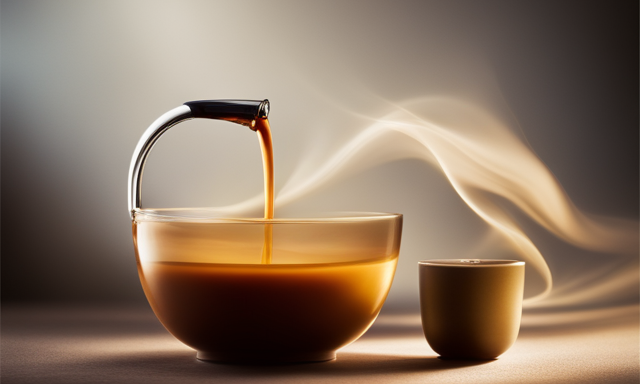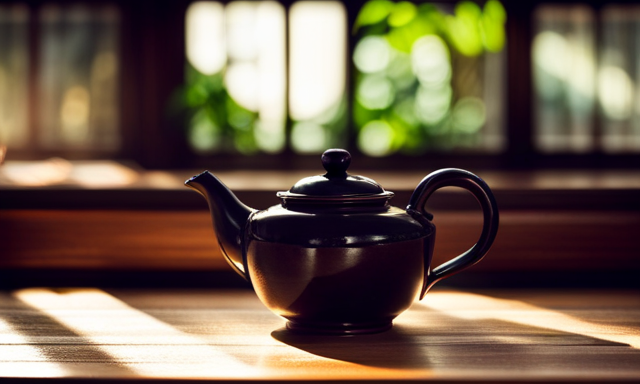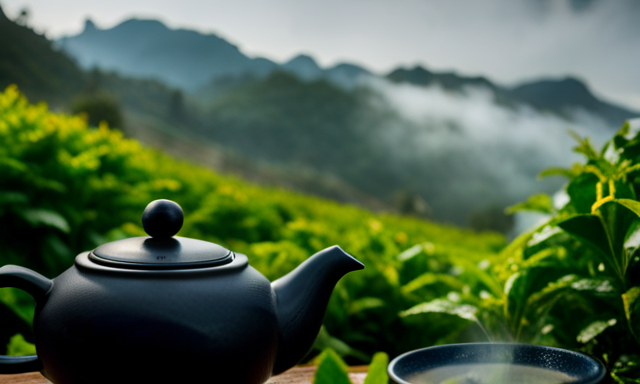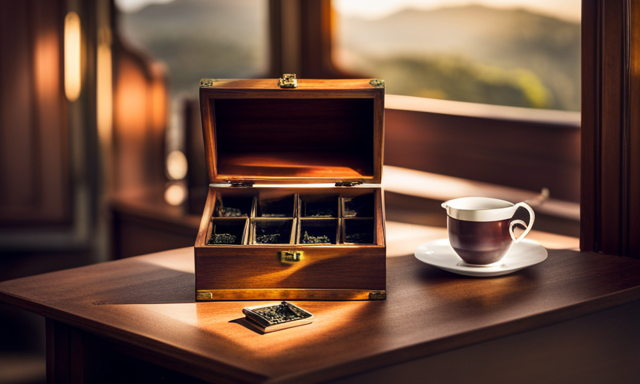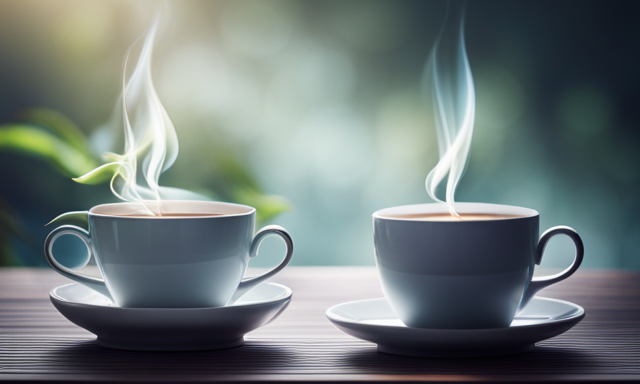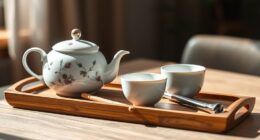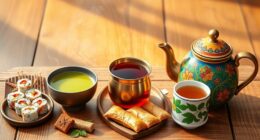You might be thinking, ‘What’s the big deal about the color of oolong tea? It’s just tea, right?’ Well, let me tell you, oolong tea is far from ordinary. Its color is not only visually appealing but also a reflection of its unique flavor and characteristics.
As a tea enthusiast, I have delved deep into the world of oolong tea, exploring its fascinating oxidation process and uncovering the secrets behind its beautiful hue. In this article, I will guide you through the different colors of oolong tea, from the light and vibrant to the dark and rich.
We will explore how processing techniques play a crucial role in determining the color of this exquisite beverage. Get ready to embark on a journey of discovery as we unravel the aesthetic appeal and flavor profiles of various oolong tea varieties.
So, grab a cup of your favorite oolong tea and let’s dive into the captivating world of color and flavor.
Key Takeaways
- Oolong tea can range in color from pale yellow or greenish to deep amber or reddish-brown.
- The color of oolong tea is influenced by the oxidation process it undergoes.
- Lighter oolong teas have a delicate and floral taste, while darker oolong teas have a richer and more robust flavor.
- The color of oolong tea correlates with its flavor profile, with depth and complexity of flavor resulting from the color.
The Oxidation Process of Oolong Tea
So, you’re probably wondering how oolong tea gets its unique color, right? Well, it all comes down to the oxidation process.
Oolong tea leaves undergo partial oxidation, which means they are allowed to partially react with oxygen. This oxidation effects the color, flavor, and aroma of the tea.
During this process, the leaves turn from green to a rich golden or amber color, depending on the level of oxidation. The longer the oxidation, the darker the color of the tea. This unique characteristic sets oolong tea apart from both green and black teas.
It has a more complex flavor profile than green tea, but is not as robust and full-bodied as black tea. So, where does oolong fit in? Let’s explore the differences between green and black tea next.
Green vs. Black Tea: Where Does Oolong Fit In?
Interestingly, oolong falls in between green and black tea in terms of oxidation levels. It has an average oxidation percentage of around 30%. This means that oolong tea is partially oxidized, unlike green tea which is unoxidized and black tea which is fully oxidized. The unique oxidation level of oolong tea gives it a distinct flavor and aroma that sets it apart from other types of tea.
When it comes to health benefits, oolong tea is known for its ability to promote weight loss, boost metabolism, and improve heart health. It contains antioxidants that help fight free radicals and reduce the risk of chronic diseases. Additionally, oolong tea is rich in vitamins and minerals that support overall well-being.
Moving on to the beautiful hue of oolong tea, its color can vary depending on the oxidation level and processing techniques. This vibrant spectrum ranges from pale yellow to deep amber, creating an enticing visual appeal.
The Beautiful Hue of Oolong Tea
Oolong tea exhibits a stunning color palette that ranges from pale yellow to deep amber. The hue of oolong tea is influenced by various factors, including the oxidation level and the processing method.
Within this range, there are also variations in shades. Some oolong teas lean towards a lighter, more delicate hue, while others boast a rich, robust amber tone.
Describing the Color Palette
The color palette of oolong tea includes various shades of amber, copper, and golden brown. These hues come together to create a visually stunning beverage that is as enchanting as it is delicious. Describing the color symbolism of oolong tea can be a fascinating exploration of cultural associations. In Chinese culture, amber symbolizes warmth and vitality, while copper represents prosperity and abundance. The golden brown shade evokes a sense of earthiness and natural beauty. To paint a vivid picture for you, imagine a table with three columns and three rows. In the first column, you have a deep amber shade, reminiscent of a glowing sunset. In the second column, a rich copper color, like a shiny penny. And in the third column, a warm golden brown, akin to freshly baked bread. Noting the variations in shades allows us to appreciate the complexity and artistry of oolong tea.
Noting the Variations in Shades
Notably, the variations in shades of amber, copper, and golden brown in the oolong tea palette paint a picture of warmth, prosperity, and natural beauty.
The color spectrum of oolong tea is truly captivating, as it ranges from light, almost translucent hues to deep, rich tones. This diversity is influenced by several factors affecting hue, including the oxidation level of the tea leaves, the length of oxidation, the degree of roasting, and the brewing method.
Each of these factors contributes to the final color of the tea, creating a visually stunning and diverse range of shades. Understanding the intricacies of the color palette adds depth and complexity to the appreciation of oolong tea.
Transitioning into the subsequent section about the influence of processing techniques, it becomes clear that the color of oolong tea is not solely determined by a single step.
The Influence of Processing Techniques
One interesting aspect of oolong tea is how its color can be influenced by different processing techniques. The importance of withering and the role of rolling are two key factors that contribute to the final color of oolong tea.
Withering, which involves exposing the tea leaves to air, helps to remove moisture and initiate the oxidation process. This step is crucial in determining the color of the tea because it affects the level of oxidation that takes place.
Additionally, the rolling process, where the leaves are twisted and shaped, further influences the color by breaking down the cell walls and releasing enzymes that react with oxygen.
These techniques, when executed with precision, result in a range of colors for oolong tea, from pale yellow to deep amber. Understanding the impact of processing techniques is essential in determining the color of oolong tea.
How to Determine the Color of Oolong Tea
When determining the color of oolong tea, there are two key points to consider: observing the dry leaves and analyzing the brewed liquor.
By examining the dry leaves, you can get a sense of the tea’s overall color, which can range from green to dark brown.
Analyzing the brewed liquor provides further insight into the tea’s color, as it can vary from pale yellow to rich amber.
Observing the Dry Leaves
The dry leaves of oolong tea unfurl like autumn leaves, revealing a rich amber hue. Analyzing the appearance of the dry leaves is the first step in understanding the processing techniques used to create oolong tea.
The color of the dry leaves can give important clues about the oxidation level and roasting methods. Oolong tea leaves can range in color from dark green to brown, depending on the degree of oxidation. The leaves may also have red or brown edges, indicating partial oxidation.
Additionally, the aroma of the dry leaves can provide further insight into the flavor profile of the brewed tea. As we move on to analyzing the brewed liquor, we can discover even more about the tantalizing world of oolong tea.
Analyzing the Brewed Liquor
As we delve into the tantalizing world of oolong tea, let’s take a moment to analyze the inviting brew that awaits us. The brewed liquor of oolong tea offers a wide range of flavor profiles, each unique to the specific tea leaves used. From floral and fruity notes to toasty and nutty undertones, oolong tea presents a complex and delightful taste experience. The significance of the tea leaves cannot be overstated, as they play a crucial role in determining the flavor and color of the brewed liquor. The leaves are carefully selected and processed to bring out the desired qualities in the tea. Factors such as oxidation level, harvesting time, and processing techniques all contribute to the final color and flavor of the oolong tea. Moving forward, we will explore the various factors that can affect the color and taste of this exquisite beverage.
Factors That Can Affect the Color
To truly appreciate the rich hue of oolong tea, let your taste buds wander through a palette of factors that can influence its captivating color.
The appearance of oolong tea can vary greatly due to several factors affecting its color. One of the most significant factors is the role of processing. The level of oxidation and fermentation that the tea leaves undergo during processing can have a direct impact on the final color of the brewed liquor.
Lighter oolong teas, such as green oolongs, are typically less oxidized, resulting in a pale yellow or greenish brew. On the other hand, darker oolong teas, like roasted oolongs, undergo significant oxidation, resulting in a deep amber or reddish-brown color.
Understanding these factors is crucial in understanding the complexity and diversity of oolong tea.
Now, let’s delve into the popular varieties of oolong tea and their colors.
Popular Varieties of Oolong Tea and Their Colors
When discussing popular varieties of oolong tea and their colors, three key varieties that come to mind are Tie Guan Yin (Iron Goddess), Da Hong Pao (Big Red Robe), and Jin Xuan (Milk Oolong).
Tie Guan Yin oolong is known for its delicate, floral aroma and its pale yellow-green color.
Da Hong Pao oolong, on the other hand, is known for its robust, roasted flavor and its deep, reddish-brown color.
Lastly, Jin Xuan oolong, also known as Milk Oolong, is revered for its creamy, buttery taste and its light golden color.
Tie Guan Yin (Iron Goddess)
The velvety smoothness of Tie Guan Yin oolong tea envelops the palate in a warm embrace, like a golden sunset painting the sky.
This exquisite oolong tea is cultivated in the Fujian province of China, where it is meticulously grown and harvested. Tie Guan Yin is known for its unique flavor profiles, which can vary depending on the specific processing methods used. It offers a delicate balance of floral and fruity notes, with hints of orchids, peaches, and a subtle sweetness.
The tea leaves are carefully hand-picked and undergo a meticulous process of withering, rolling, and oxidation, resulting in its distinct flavor and aroma.
As we transition to the next section about ‘da hong pao (big red robe)’, a legendary oolong tea, we delve into another fascinating aspect of the world of oolong teas.
Da Hong Pao (Big Red Robe)
Like a majestic cloak of autumn leaves, Da Hong Pao oolong envelops the senses with its rich and robust flavor profiles.
Da Hong Pao, also known as Big Red Robe, is a highly revered and prestigious oolong tea originating from the Wuyi Mountains in China. Its dark, twisted leaves brew a deep amber liquor with a complex taste that is both floral and fruity, with hints of roasted nuts and a lingering sweetness.
The unique terroir and traditional processing methods contribute to its exceptional quality and distinct flavor. The bold and full-bodied nature of Da Hong Pao makes it a perfect choice for those seeking a tea that is both invigorating and satisfying.
Transitioning into the subsequent section about Jin Xuan (milk oolong), one can explore the contrasting characteristics of this creamy and delicate oolong variety.
Jin Xuan (Milk Oolong)
Indulge yourself in the creamy and delicate allure of Jin Xuan, the velvety sweetness of this oolong will transport you to a world of pure tea bliss.
Here’s what you need to know about Jin Xuan:
-
Milk flavor: Jin Xuan oolong is known for its unique milk flavor that sets it apart from other teas. This natural flavor is achieved through a special production process that involves growing tea leaves at higher altitudes and carefully controlling the temperature during oxidation.
-
Production process: The leaves of Jin Xuan oolong are hand-picked and then withered under the sun. They are then lightly oxidized, which gives the tea a smooth and rich taste. The leaves are finally rolled into tight balls and dried to preserve their flavor.
-
Aesthetic appeal: Not only does Jin Xuan oolong taste exquisite, but it also has a visually appealing appearance. The tightly rolled leaves unfurl in hot water, releasing a mesmerizing aroma and creating a beautiful golden liquor.
With its milk flavor and unique production process, Jin Xuan oolong is a true delight for tea enthusiasts.
Now, let’s explore the aesthetic appeal of oolong tea.
The Aesthetic Appeal of Oolong Tea
Savor the sight of oolong tea, with its warm amber hue reminiscent of a sunset over rolling hills. The visual appeal of oolong tea is undeniable, as its color alone can captivate the senses.
As a tea enthusiast, I appreciate the art of brewing oolong tea, carefully steeping the leaves to achieve the perfect balance of flavor and aroma. The amber color of oolong tea is a testament to the craftsmanship involved in its production.
But does the color of oolong tea correlate with its flavor? That is the question we will explore in the next section. The color of oolong tea is just the beginning, as its taste profile is equally intriguing.
Color and Flavor: Is There a Correlation?
Get ready to delve into the fascinating relationship between the captivating hue and delightful taste of oolong tea. When it comes to oolong tea, color and flavor are intertwined in a way that is truly captivating. The correlation between the color and flavor in oolong tea is undeniable. As the leaves of the tea undergo a partial oxidation process, they develop a wide range of colors, from light green to dark brown. This oxidation process not only affects the color of the tea, but also has a significant impact on its flavor profile. Lighter oolong teas tend to have a more delicate and floral taste, while darker oolong teas have a richer and more robust flavor. The depth and complexity of flavor in oolong tea is truly a result of its color. Now, let’s delve into embracing the beauty of oolong tea, where we will explore its aroma and taste in greater detail.
Embracing the Beauty of Oolong Tea
Immerse yourself in the enchanting allure of oolong tea as you explore its captivating aroma and taste. Oolong tea, with its delicate and floral fragrance, is a treat for the senses. As you take a sip, you’ll be greeted by a refined and slightly sweet taste that lingers on your palate. The aroma is a symphony of floral notes, reminiscent of orchids and jasmine, intermingled with a hint of roasted nuts.
But oolong tea is not just a feast for the senses, it also offers numerous health benefits. Packed with antioxidants, it helps boost your immune system and protects against oxidative stress. It also aids in weight management by boosting metabolism and promoting fat oxidation. Additionally, oolong tea supports heart health by reducing cholesterol levels and regulating blood pressure.
With its delightful aroma and a myriad of health benefits, oolong tea truly is a beverage to be cherished.
Frequently Asked Questions
How long does the oxidation process of oolong tea typically take?
The oxidation process of oolong tea typically takes around 1-2 hours, resulting in a color variation ranging from green to brown. This transformation significantly affects the flavor and aroma of the tea leaves.
What are the main differences between green tea, black tea, and oolong tea in terms of color?
Green tea is known for its numerous health benefits, while black tea is famous for its strong flavor. Oolong tea falls in between, combining the best of both worlds with a balanced taste and color that can range from light to dark.
Are there any health benefits associated with the specific hue of oolong tea?
The hue of oolong tea can impact its health benefits. Different hues may indicate varying levels of antioxidants and nutrients, which can contribute to improved digestion, weight management, heart health, and mental alertness.
Can the color of oolong tea be influenced by the brewing technique?
Yes, the color of oolong tea can be influenced by the brewing technique. The temperature and steeping time have a significant impact on the color of oolong tea, resulting in varying shades and hues.
Are there any artificial factors that can affect the color of oolong tea?
Artificial additives and environmental factors can influence the color of oolong tea. Additives like food coloring can be used to enhance or alter the natural color, while factors like sunlight and soil composition can affect the tea leaves’ pigmentation.
Conclusion
In conclusion, the color of oolong tea is a fascinating topic that showcases the intricate process of oxidation and the influence of various processing techniques.
One interesting statistic to note is that the color of oolong tea can range from a vibrant green to a deep amber, depending on the level of oxidation.
This variation in color not only adds to the aesthetic appeal of oolong tea but also contributes to the diverse flavors and aromas that it offers.
Embracing the beauty of oolong tea means appreciating its rich hues and indulging in its exquisite taste.

